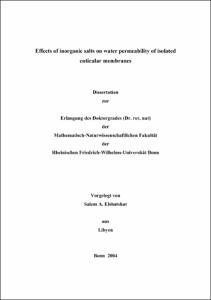Elshatshat, Salem A.: Effects of inorganic salts on water permeability of isolated cuticular membranes. - Bonn, 2005. - Dissertation, Rheinische Friedrich-Wilhelms-Universität Bonn.
Online-Ausgabe in bonndoc: https://nbn-resolving.org/urn:nbn:de:hbz:5N-04961
Online-Ausgabe in bonndoc: https://nbn-resolving.org/urn:nbn:de:hbz:5N-04961
@phdthesis{handle:20.500.11811/2135,
urn: https://nbn-resolving.org/urn:nbn:de:hbz:5N-04961,
author = {{Salem A. Elshatshat}},
title = {Effects of inorganic salts on water permeability of isolated cuticular membranes},
school = {Rheinische Friedrich-Wilhelms-Universität Bonn},
year = 2005,
note = {The effect of 0.2 M inorganic salt solutions on cuticular transpiration of isolated cuticular membranes (CM) of the three species Hedera helix L., Prunus laurocerasus L., and Lycopersicon esculentum Mill. was measured. Water permeability was not increased by AlCl3, AlCl3, NH4Cl, NH4NO3, (NH4)2SO4, KNO3, KCl, NaNO3 and NaCl. However, when cuticles were treated with CaCl2, K2CO3 and Cs2CO3, cuticular transpiration was significantly increased. Depending on the species, relative effects of the tested salt solutions varied between 1.5- to 3-fold. Wax-free polymer matrix membranes (MX) of H. helix and P. laurocerasus were not affected by the 3 salts, whereas, cuticular transpiration of L. esculentum MX significantly increased, after treatment with K2CO3 and Cs2CO3. Effects on cuticular transpiration were positively correlated with the increasing cation radii of the monovalent cations.
Water permeability increased linearly with the amounts of K2CO3 applied per cuticle surface area. Treatment of the morphological inner sides of the CM with different concentrations of K2CO3 was more effective increasing cuticular water permeability than treatment of the morphological outer sides. There was no correlation between the wax coverage of the cuticles and the effects of the salts. Using three different pH values (2.9, 6.9 and 10.9), an increase of cuticular permeability was observed with P. laurocerasus at the high pH value of 10.9. At high external air humidities, effects of K2CO3 on water permeability of Prunus laurocerasus L. CM were significantly increased by a factor 4.57. Salt effects were partially reversible when cuticles were washed with water. It is argued that inorganic salts were sorbed to polar domains of the cuticles. As a consequence amounts of water sorbed to the cuticles were increased, which in turn increased rates of cuticular transpiration.
Furthermore, it was shown for the first time in this thesis, that polar domains in cuticles, potentially serving as polar paths of diffusion for polar, charged molecules like inorganic salts, could be blocked by the precipitation of AgCl crystallites in the cuticular membranes of 15 species. AgCl precipitations significantly reduced cuticular transpiration between 2 to 3-fold in 13 of the15 species investigated. Strongest effects were observed with Prunus domestica fruit CM and Populus canescens leaf CM. Investigation of treated CM by light microscopy clearly showed black AgCl precipitations and effects on water permeability of cuticles increased with increasing diameters of the AgCl precipitations.},
url = {https://hdl.handle.net/20.500.11811/2135}
}
urn: https://nbn-resolving.org/urn:nbn:de:hbz:5N-04961,
author = {{Salem A. Elshatshat}},
title = {Effects of inorganic salts on water permeability of isolated cuticular membranes},
school = {Rheinische Friedrich-Wilhelms-Universität Bonn},
year = 2005,
note = {The effect of 0.2 M inorganic salt solutions on cuticular transpiration of isolated cuticular membranes (CM) of the three species Hedera helix L., Prunus laurocerasus L., and Lycopersicon esculentum Mill. was measured. Water permeability was not increased by AlCl3, AlCl3, NH4Cl, NH4NO3, (NH4)2SO4, KNO3, KCl, NaNO3 and NaCl. However, when cuticles were treated with CaCl2, K2CO3 and Cs2CO3, cuticular transpiration was significantly increased. Depending on the species, relative effects of the tested salt solutions varied between 1.5- to 3-fold. Wax-free polymer matrix membranes (MX) of H. helix and P. laurocerasus were not affected by the 3 salts, whereas, cuticular transpiration of L. esculentum MX significantly increased, after treatment with K2CO3 and Cs2CO3. Effects on cuticular transpiration were positively correlated with the increasing cation radii of the monovalent cations.
Water permeability increased linearly with the amounts of K2CO3 applied per cuticle surface area. Treatment of the morphological inner sides of the CM with different concentrations of K2CO3 was more effective increasing cuticular water permeability than treatment of the morphological outer sides. There was no correlation between the wax coverage of the cuticles and the effects of the salts. Using three different pH values (2.9, 6.9 and 10.9), an increase of cuticular permeability was observed with P. laurocerasus at the high pH value of 10.9. At high external air humidities, effects of K2CO3 on water permeability of Prunus laurocerasus L. CM were significantly increased by a factor 4.57. Salt effects were partially reversible when cuticles were washed with water. It is argued that inorganic salts were sorbed to polar domains of the cuticles. As a consequence amounts of water sorbed to the cuticles were increased, which in turn increased rates of cuticular transpiration.
Furthermore, it was shown for the first time in this thesis, that polar domains in cuticles, potentially serving as polar paths of diffusion for polar, charged molecules like inorganic salts, could be blocked by the precipitation of AgCl crystallites in the cuticular membranes of 15 species. AgCl precipitations significantly reduced cuticular transpiration between 2 to 3-fold in 13 of the15 species investigated. Strongest effects were observed with Prunus domestica fruit CM and Populus canescens leaf CM. Investigation of treated CM by light microscopy clearly showed black AgCl precipitations and effects on water permeability of cuticles increased with increasing diameters of the AgCl precipitations.},
url = {https://hdl.handle.net/20.500.11811/2135}
}






